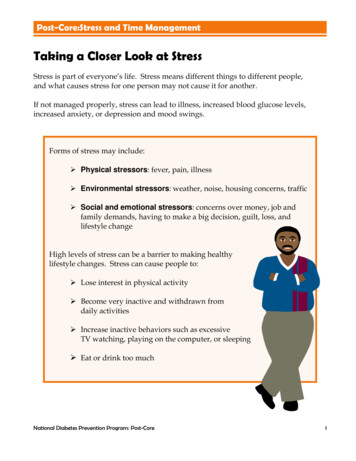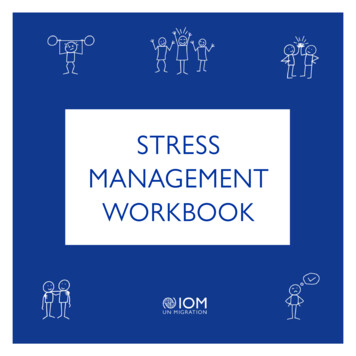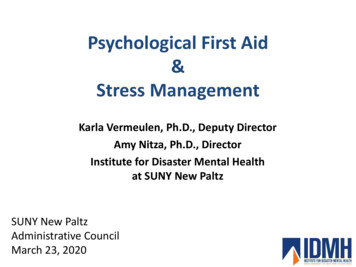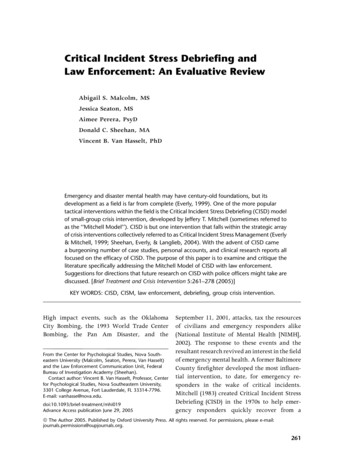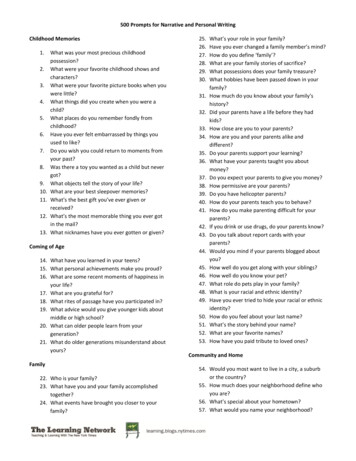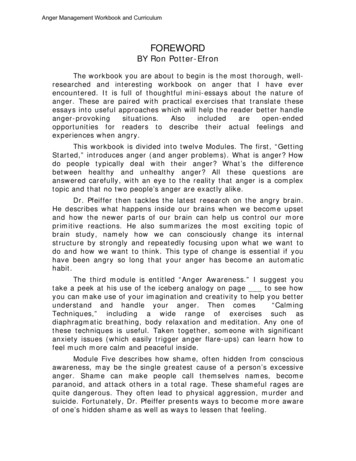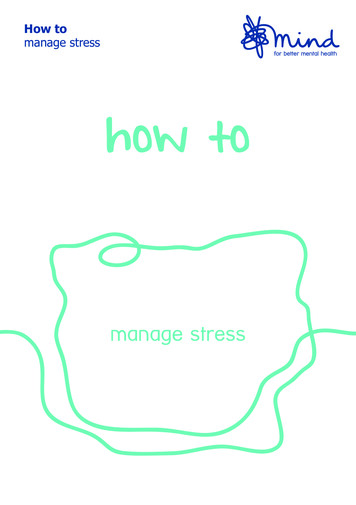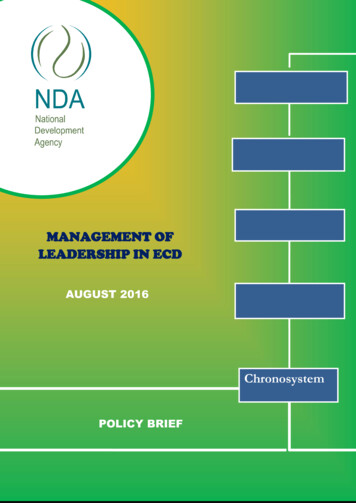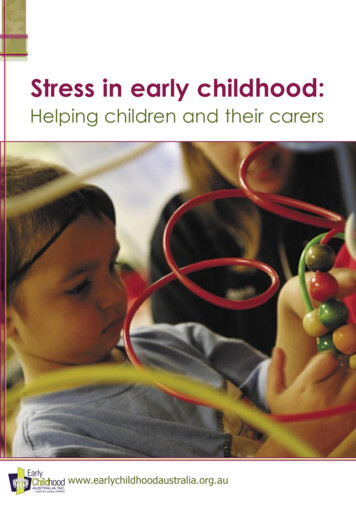
Transcription
Stress in early childhood:Helping children and their carerswww.earlychildhoodaustralia.org.au
About Early Childhood AustraliaEarly Childhood Australia, formerly theAustralian Early Childhood Association, activelypromotes the provision of high quality servicesfor all young children from birth to eight yearsand their families, and supports the importantrole of parents. Early Childhood Australia is alsothe national umbrella organisation for children’sservices and a leading early childhood publisher.Membership, subscription& advertising inquiries:Early Childhood Australia Inc.PO Box 7105 Watson ACT 2602Tel:02 6242 1800Fax:02 6242 1818Sales line (toll free): 1800 356 900Email: eca@earlychildhood.org.auEdition EditorAlison ElliottSeries EditorSue WalesAbout the authorPatrice Thomas has been an early childhood/special education teacher and universitylecturer for over 20 years. She is theauthor of The Magic of Relaxation (2002)Pademelon Press, Sydney and The Power ofRelaxation (2003) Redleaf Press, Minnesota,and has also written articles for a range ofpublications such as Every Child; Child CareInformation Exchange; Reflections (GowrieRAP); Childcare and Children’s Health;and Journal of Early Childhood TeacherEducation.Publishing & MarketingDavid KingwellAlana van MeursGraphic DesignClaire ConnellyCover PhotographAndrew SikorskiPhotosA. SikorskiPatrice ThomasPatrice is a consultant to early childhood,education, health and corporate groups.She presents workshops and trainingseminars on Stress Management;Communication Skills; ConflictManagement; Relaxation for Children andSpirituality in Young Children’s Lives. Patriceis also invited to speak at various cancersupport groups and she has developed twoCDs to accompany her relaxation techniquesand exercises, both of which are availablefrom www.newworldmusic.com.au Copyright 2006All rights reserved byEarly Childhood Australia Inc.Material herein must not be reproducedin any form without the written permissionof Early Childhood Australia Inc.ISBN 1-921162-00-7Printed by Paragon Printers, CanberraPatrice is passionate about helping adultsand children to develop wellbeing andhealth through techniques that are holisticand simple to use in childcare, school,work or home environments. She can becontacted on (02) 4784 2904 or email:patrice.thomas@bigpond.com
ContentsIntroduction2What is stress?2What is the stress response?2Stress and children4What are some of the causes of stress for young children?5How do children experience stress?7The long-term effects of stress8The spiritual child9Transforming education through relaxation and reflection with children10Educating children for the 21st Century11The courage to transform12Making relaxation contagious12Relaxation for children with special needs17Stress in carers of young children19Developing a balance in life19Stress is a problem for organisations22Signs and symptoms of stress in early childhood practitioners23Unproductive habits24Relaxation is the opposite of stress25Developing a stress management plan26Communication skills28Time management30The environment31Breathing techniques33Exercise33Relaxation34Personal empowerment practices35Tips for crises and the unexpected in the early childhood day36References38Stress in early childhood: Helping children and their carers1
IntroductionWhat is stress?Stress is a complex phenomenon. It has different meanings to different people and can bevery subjective. What is stressful for one person might not be stressful for the next. It dependslargely on background experiences, temperament and environmental conditions.Stress has been defined variously as:’ the non-specific response of the body to any demand that exceeds the person’s abilityto cope; as a person–environment relationship that threatens or taxes personal resources,and as a mental state in response to strains or daily hassles.’ (Manning and Curtis, 1988;Allen, 1992.)Occupational stress stems from conditions in the workplace. These conditions may either causestress initially or aggravate the stress already present from other sources (Dillenburger, 2004).Eustress and distressMany people use the terms stress and distress as though they are interchangeable. Thecommon view is that stress is something bad. Hans Seyle, the ’father‘ of stress management,introduced the terms distress and eustress. According to Selye (1976), distress is ’damagingor unpleasant stress‘ (p. 31), where the core response is negative, painful and somethingto be avoided. Eustress describes a positive view of stress or a challenge—something to besought out and used as an ally for personal and professional growth. Examples of eustressare anticipation of a holiday or the arousal needed to create a work of art. Eustress heightensawareness, increases mental alertness, and can lead to superior cognitive and behaviouralperformance (Rice, 1999).The education and child care fields are not immune from thisphenomenon. Stress is associated with problems of recruitment, healthand retention of early childhood staff. Jarvis (2002) believes there aregaps in our understanding of teacher stress, most notably regardingeffective interventions. This book aims to offer some practical andeffective strategies for stress management in early childhood staff andthe children in their care.‘The body’s aim is to comeback to a state of balance(homeostasis) after beingstressed. This return tostability and balance isimportant for maintaininghealth and wellbeing.’What is the stress response?According to Montgomery and Evans (1995), the stress response is a state of arousal consistingof a number of bodily changes that present as feelings of being stressed. It also refers to theenergy levels required for tackling the stressful situation.The body’s aim is to come back to a state of balance (homeostasis) after being stressed.This return to stability and balance is important for maintaining health and wellbeing.In extreme cases, this response is described as ’fight or flight’—see opposite. However, theresponse occurs so often in its mild form that it often passes unnoticed.2Stress in early childhood: Helping children and their carers
Stress becomes a problem when stress reactions are so severe, occur frequently or over a longperiod of time that the person is unable to handle them effectively. Stress also becomes aproblem when a person constantly has feelings of being over-stretched, fatigued, having poorjudgement, and achieving little in relation to the effort involved. As a consequence, the personis more susceptible to illness because the body’s resistance to disease decreases under stress.Cannon (1932) was the first writer to propose the ’fight or flight‘ response, meaning that whena person is stressed, the body is rapidly aroused and motivated by the sympathetic nervoussystem. The ’fight or flight’ response prepares the body for action. The muscles tense, the heartrate escalates, thought becomes rapid, perspiration increases and breathing quickens. The bodyis ready to fight or run from the perceived threat. Back through the ages, this response wasnecessary for survival (the ‘survival of the fittest’); for example, when the threat was physicaldanger, such as confrontation with a large, hungry animal.What happens to the body when it enters the ‘fight or flight’ state? Breathing becomes shallow and rapid. The heartbeat increases. Blood pressure rises. Adrenaline and other hormones are released into the blood. The senses are heightened. The liver releases stored sugar into the blood. Muscles tense and tighten. Blood flow increases to the brain and major muscles and isconstricted to the extremities.In contemporary times, the more probable causes of stressare related to relationships, financial worries and performanceanxieties. In our society it is not often necessary to fight tosave our lives, but we still respond the same way to danger,whether real or imagined. This physiological response is nolonger appropriate for the types of stress we commonlyexperience, but it comes into play whenever our stress levelsincrease. We can get into a state where the stress response isoperating all the time. This can result in repression of storedup energy or inappropriate release of it, often in negativeor destructive ways. These can include reliance on alcohol,excessive eating, smoking and other drug abuse.Other typical and harmful stress release responses are anger,emotional and psychological withdrawal, and depression. Thedanger lies in the stress reaction itself and how we choose torelease or repress our stored-up energy.Stress in early childhood: Helping children and their carers3
Stress and childrenIf there is light in the soul, there is beauty in the person,If there is beauty in the person, there will be harmony in the house,If there is harmony in the house, there will be order in the nation,If there is order in the nation, there will be peace in the world.AnonymousIn recent years, changes in childhood, family life and culture have caused early childhoodprofessionals to seek new approaches to managing the stresses experienced by young children.It is possible to teach children proactive ways to manage stress from an early age. They can gainmore personal control in their lives when they learn to relax, focus and de-stress.Many professionals are worried that the task of growing up in today’s stressful world is gettingtougher. Although not all children are experiencing difficulty, increasing numbers apparentlyhave fewer sources of adult support, affirmation and love than in the recent past. Manychildren are being pressured to grow up faster (Elkind, 1988; Kostelnik et al., 1998).Childhood stresses are many and varied. These can‘Many professionals are worried thatrange from day-to-day upsets about being teasedthe task of growing up in today’sby others or fighting over toys, to the damagingstressful world is getting tougher.’experience of being physically and sexually abused.There are societal concerns about the growingnumbers of chronically unhappy, hyperactive, or lethargic and unmotivated children nowbeing seen by clinicians. If these youngsters’ problems are not addressed, they may be inclinedtowards school failure, psychosomatic problems, and early involvement in antisocial behaviourand substance abuse. Such children have been described as the ’unwilling, unintended victimsof overwhelming stress borne of rapid, bewildering social change and constantly risingexpectations‘ (Elkind, cited in Kostelnik et al., 1998).The research literature tends to highlight the impact of single-variable stressors on children’sdevelopment. However, in real life, everyday situations, such as out-of-home care and school,children experience stress from multiple sources. Multiple stressors interact with one anotherand can have cumulative effects.Furman (1995) believes that stresses affecting children should not be avoided when they ortheir derivatives impinge on the classroom—he believes they may offer optimal opportunitiesfor effective early childhood education.’ dealing effectively with stresses as well as with feelings, requires a cooperativerelationship between the child’s teachers and particularly between the teacher and theprimary mothering person’ (p. 33).When child care professionals and families work collaboratively, children can become moreresilient by learning to recognise and manage stress in their lives.4Stress in early childhood: Helping children and their carers
What are some of the causes of stress for young children?Figures from the Australian Bureau of Statistics (ABS, 2002) reveal marked increases in thenumbers of children receiving child care—both formal and informal. Other recent social trendsindicate that people are working longer hours (often as unpaid overtime) and that increasingnumbers of households are experiencing financial stress. Additionally, one in four children doesnot live with both their natural parents (ABS, 2002). Along with a significant proportion of thepopulation (one in four) experiencing some form of mental illness, are the common disordersof anxiety, substance abuse and depression (ABS, 2002), which impact negatively on youngchildren.Australia has one of the highest rates of youth suicide in the world, and alcohol and drugdisorders are increasing in young people. The activity levels of Australians are decreasing.Fewer and fewer Australians are participating in physical activities and sports, and more areexperiencing the stress-related problems of a sedentary lifestyle. This is also leading to increasedobesity levels in children and adults. Additionally, the ‘24/7’ economy has permeated ourlifestyles, where work can intrude anywhere and everywhere. Many workers are described asbeing perpetually attached to work via a digital ’leash’—pagers, mobile phones, palm devicesand laptops. These factors impact upon adults and children alike (Thomas, 2003).As a result of our living complex and fast-paced lives (Kostelnik et al., 1998), and as children’sinteractions broaden beyond the family, the child’s world becomes potentially more stressful.There is a wide range of causes of stress for young children (stressors). These include somechildren’s personalities and temperaments. For example, some children never feel comfortableor happy in any setting, no matter how inclusive and diverse the program offered. Somechildren have difficulty getting along with their parents, peers, siblings and people in general.Kostelnik et al. and Miller (1996) describe a range of stressors experienced by children:‘Family life, which often serves as a buffer for children, also can be a source of stress forthem. The ordinary aspects of family life may pile up to create demands for children thatrange from mildly stressful to overwhelming. The birth of a sibling, the death of a pet,breaking a favourite toy, getting caught stealing or lying, carelessly spilling milk, losinga grandparent, or bringing home a bad report card all can be either opportunities forgrowth or highly negative experiences, depending on the responses of significant adults.’(Kostelnik et al., 1998, p. 135)Family stressors include factors such as: separation and divorce of parents single-parent families working parents blended families children in abusive or neglectfulfamilies and death children in foster care.Stress in early childhood: Helping children and their carers5
Environmental stressors include: poor-quality child care learning difficulties stress in formal school settings the death of a pet cultural isolation a new baby in the family stress and trauma as a result of fleeingfrom their homes, travelling to anew country, waiting for applicationsfor refugee status to be approved(often in detention centres) andadapting to a new country starting school health-related assaults, illness orhospitalisation disability bullying or teasing at school spending time with a number ofcaregivers long hours in care and after-schoolsettings natural disasters war, terrorism and violence.Greenman (2002) believes that crises can bring out the best and worst in all of us, but it is theadults’ role to guide children towards thoughtfulness, caring, kindness and courage.Pushing children to achieve too much at an early age can cause them to burn out. Someparents are so keen for their children to live up to their potential that they expect them tobe busy and occupied nearly every waking moment. Elkind (1988) refers to this as ’forcedblooming’ and highlights the usurping of important play experiences for children by adultdirected extra-curricular activities. This rapid-paced, high-geared, fast-foodsociety is often referred to as ’socially toxic’. Furthermore, many of the markers ‘Pushing childrento achieve toothat indicated the passage from childhood to adulthood are becoming blurred,much at an earlyas children are increasingly encouraged to copy adult dress, aspirations andage can causebehaviour (for example, becoming little ‘stars’ orthem to burn out.’models and being exposed to inappropriate imagesand interactions on the Internet, X-box games andtelevision and movies). It is not surprising that, in our society, mostchildren conclude that the status of personhood is attained bybecoming a consumer.The message from the marketplace to children is ’I buy, therefore Iam.’Success at school and in other activities is important and worthwhile,but not at the expense of children’s wellbeing and happiness.Children’s responses to stress vary according to the individual child’stemperament and personality, the child’s developmental level and thechild’s previous life experience. Managing stress appears to be highlydependent on a child’s developmental capabilities and coping skills.6Stress in early childhood: Helping children and their carers
How do children experience stress?There are two main categories of stressful experiences: Acute stress is a sudden intense onset of the stressful situation (e.g. a car accident). Chronic stress (e.g. the loss of a loved one) is ongoing and, according to Gunnarand Barr (1998), the most significant and detrimental for children. The effects includechanging brain chemistry and function, and a lowering of resistance to disease.In early childhood, we need to address the above concerns about stress in effective and creativeways so that carers of children and children themselves can learn about and practise stressmanagement techniques that are holistic—working on the body, mind, emotions and spirit.Teachers, child care workers and parents all need to find a balance between encouragingchildren to experience success in life and encouraging them just to be children. Positivepractices undertaken daily in child care and education settings can create a real difference inchildren’s lives. Additionally, the carers, teachers and parents can work together and gain thebenefits of holistic stress management techniques along with the children in their care.Children’s responses to stressChronic and acute stress are likely to have a negative andfar-reaching impact upon the health, development andwellbeing of our children. If children are confronted with toomany stressful situations, or if the stresses are too severe,the strain can become too great for them to handle (Rickard,1996; Pearson, 1998; Greenman, 2002; Thomas, 2003).Stress impacts adversely on children’s physical, psychological,emotional and spiritual wellbeing, as well as their social skillsand their ability to concentrate and learn (Honig, 1986; Elkind,1988; Romano, 1992; Youngs, 1995; Thomas, 2003).‘Teachers, child careworkers and parents allneed to find a balancebetween encouragingchildren to experiencesuccess in life andencouraging them just tobe children.’Modelling empathy and compassionEarly childhood practitioners have very little control over the circumstances of children’s livesoutside the child care centre or the classroom. We can’t prevent bad things from happeningto children or eliminate harmful stressors from their lives. But we can look beyond whatwe deem as the ‘inappropriate’ behaviours and the responses children sometimes display inthe classroom, to the real causes of stress in their lives. We can also model ways of dealingwith stress to the children and their parents and exhibit calmness and strength in the faceof difficulties. In this way we can treat all children and their families with compassion andunderstanding and, in turn, teach them the all-important life skills of learning to reduce theirnegative responses to stress.Relaxation skills form an important part of self-coping skills for children and, when learnedeffectively, can stay with them throughout their lives.Unlike adults, children are generally unable to verbalise their feelings, often not having thewords to describe their fears and worries, nor are they able to take positive action towardsmanaging stress when it arises.Stress in early childhood: Helping children and their carers7
Children react to stress and change inmany ways, including: defence mechanisms, such as denial,regression, withdrawal and impulsiveacting-out.These stress responses can allow thechild to temporarily gain a sense ofcontrol or balance. However, thesedefence mechanisms are generally notproductive in the long term and canlead to more serious stress responses.These include: distractibility sleep disturbances and bedwetting self-harm pulling out their hair temper tantrums running away defying significant others unusual fears or preoccupations withdeath panic refusal to respond when others talk tothem depression refusal to play with their peers. irritability(Kostelnik et al., 1998)The long-term effects of stressWhen children’s stress symptoms are not recognised or managed effectively, long-term effectscan be serious and may include behavioural and social problems, mental illness, ill health andlack of fulfilment, wellbeing, resilience and happiness in life.Raynor and Montague (1999, cited in Deveson, 2003) reveal some important characteristics ofresilient children. These include: emotional intelligence—which involves self-esteem and confidencethe ability to create and maintain friendshipsa sense of purpose‘Developing resilient and happya set of values and beliefschildren is the responsibility ofan internal locus of control.early childhood practitioners,Parents, teachers and caregivers are concerned aboutworking in partnership withthe effect of stress on the lives of young children butyoungsters and their families.’are often at a loss as to how to deal with it (Youngs,1995). Consequently, there is a risk of ‘bandaid’measures or inappropriate ‘quick fix’ practices being adopted.Developing resilient and happy children is the responsibility of early childhood practitioners,working in partnership with youngsters and their families. Arming children with a range oftechniques and approaches to manage and reduce their stressful responses enhances theirability to learn, relate to others and feel good about themselves.8Stress in early childhood: Helping children and their carers
The spiritual childMention of nurturing children’s spirits is sparse in early childhood literature. The NSWCurriculum Framework for children’s services states, ’ spirituality is about reverence for lifeand appreciation of beauty in nature and creative endeavours’ (2002, p. 72).Early childhood practitioners are encouraged to develop in children an attitude of respectand caring for others and a deep sense of their own obligations to other life. Spirituality isalso about respecting the religious customs and beliefs of all families in the children’s servicecommunity.One hundred years ago, Maria Montessori paved the way for early childhood practitioners tonurture children’s spirits:’If education recognises the intrinsic value of the child’s personality and provides anenvironment suited to spiritual growth, we have the revelation of an entirely new childwhose astonishing characteristics can eventually contribute to the betterment of theworld.’‘The world our children(Montessori, cited in Wolf, 2000).will inhabit will be vastlySadly, until recent times, this advice has been largely ignored.different from anythingwe have experienced.’Wolf poses the following questions to early childhood teachersand carers: ’Who is to tell children that there is much more to life than accumulating more andmore things?’ ‘Who is to tell them that their real value as human beings lies within themselves andhow they treat others, rather than what they possess?’One way to answer these questions is to introduce a stress management program into earlychildhood settings. This can take the form of daily rest and relaxation sessions, be part ofenvironmental or values education, or stem from a focus on peace programs.The world our children will inhabit will be vastly different from anything we have experienced.We are facing an era when issues of culture, difference and diversity need to be explored withcompassion and humanity. When we educate children with a range of choices about howto respond to life challenges and stresses in calm and thoughtful ways, we are helping themface the challenges of this century with tolerance, freedom, openness, reverence, respect andcompassion.Stress in early childhood: Helping children and their carers9
Transforming education through relaxation and reflection with childrenDavis and Elliott (2003), writing about environmental sustainability and education for change,assert that current educational practices need an overhaul because they do not take a holistic,integrated, empowering approach. These writers, like Wolfe (2000), believe contemporaryWestern society has an obsession with material and monetary growth, the subjugation ofnature, marginalisation of non-Western cultures and the manipulation of vulnerable groupsto meet the demands of the economy (2003, p. 2). Accordingly, these writers believe thattransformative education means having a focus on a variety of approaches to education, inorder to help young children become resilient individuals, able to critically reflect upon and actknowledgeably, responsibly and creatively in a world of change (2003, p. 4).A key tenet of a transformative approach to education is the necessity to help children copewith rapid change.The holistic and integrated approaches offered in relaxation and awareness sessions provide thekey to helping carers transform their practice and make significant changes in the lives of thechildren and families attending their service.Part of transforming education means reassembling familiar classroom techniques into aworkable model that focuses on high-quality student learning and improved outcomes forall learners. Productive pedagogy (NSWDET, 2002) draws teachers’ and carers’ attention towhat really matters in helping children to learn. This approach requires attention to four‘dimensions’—intellectual quality (including higher-order thinking, deep knowledge, substantiveconversation, knowledge as problematic and metalanguage); relevance/connectedness(including connectedness to the world, problem-based curriculum, knowledge integration);a socially supportive classroom environment (including learner control and support ofengagement, self-regulation, explicit criteria) and recognition of difference (including culturalknowledges, inclusivity, narrative, group identity and citizenship).Human ecology is an area often overlooked when we are searching for ways to address theall-encompassing malaise of our time—stress. Human sustainability is possible only if ourethics and values undergo core changes—along with our lifestyles. Part of this lifestyle changeinvolves learning how to balance our lives with quiet and replenishing techniques that providerest, rejuvenation and hope. While education is not the complete answer (Davis & Elliott, 2003),education ‘must be a vital part of all efforts to imagine and create new relations among peopleand to foster greater respect for the needs of the environment’ (UNESCO, 1997, p.15, cited inDavis & Elliot, 2003).10Stress in early childhood: Helping children and their carers
Educating children for the 21st CenturyWe face an era when issues of culture and diversity need to be explored with compassion andhumanity. What elements should form part of a child’s ‘toolkit’ to face the challenges of thiscentury? Tolerance—children need to appreciate that we subscribe to different religions, beliefsand philosophies and that this difference is healthy and democratic. Beginning to learnthis at an early age increases children’s chances of living in a peaceable world. Freedom—children need to learn that each individual has basic human rights and thatone of these is to worship or not, as he or she sees fit, provided it doesn’t harm anotherhuman being.There are many forms of spirituality that human beings can embrace. Inquisitiveness—children can learn to find solutions to problems and to speak out andexplore issues they sense as wrong. It is a basic human right to seek clarification of thosethings we don’t understand. Openness to diversity—it is our duty as early childhood practitioners to help childrenlearn something meaningful about other faiths, practices, and philosophies. Sharingbooks about different cultural practices, beliefs and lifestyles, and inviting parents andcommunity members to the centre/school is a way of ‘opening the door’ to appreciationof multiculturalism and acceptance of all people. Reverence for and intimacy with nature—when we become alienated from our naturalworld, our view of our place in the world becomes distorted. Respect and care for theenvironment comes from helping children develop a sensibility that they are one part ofthe web of life and are connected spiritually to the planet.We need to change the prevailing economic-driven world view to a sustainable, postmaterialist world that embraces earth stewardship and the needs of future generations(Davis & Elliott, 2003). Respect for Indigenous traditions—it isimportant to cultivate in children a respect fornative cultures and their spiritual traditions.Indigenous peoples have, in many instances,maintained an intimate connection with nature.When young children learn about native culturesand traditions, they are also building their ownspiritual connections to the natural world. Compassion—we teach children compassionby being compassionate ourselves. Listeningto children and validating their experiencescommunicates empathy and understanding.Allow children to observe you engaging in actsof compassion towards others, as well as takingcare of yourself (Thomas, 2003).Stress in early childhood: Helping children and their carers11
The courage to transformMany early childhood professionals, early years’ teachers and parents are frustrated and at aloss as to how to bring calm and peace into children’s daily lives. Remember, change is abouttaking the first step an
stress initially or aggravate the stress already present from other sources (Dillenburger, 2004). Eustress and distress Many people use the terms stress and distress as though they are interchangeable. The common view is that stress is something bad. Hans Seyle, the ’father‘ of stress managem
